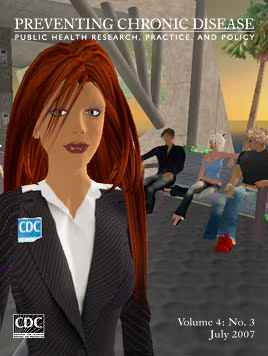 |
|
||||||||
|
|
| Home |
Volume 4: No. 3, July 2007

|
||
Virtual worlds have increased in visual detail and complexity, facilitated by excellent graphics cards and high-speed Internet connectivity, but as social networks they are still maturing. Victorian-era mechanical devices, such as the telegraph, facilitated not only rapid information transmission but also social exchange among people far distant from one another (1). Twentieth century technology went beyond signals to sounds and visuals, such as radio and television, to connect people and places with actual and vicarious experiences. In the 21st century, the growth of the Internet has contributed to the emergence of virtual communities featuring “avatars,” graphic self-representations created by Internet users for participation in online social networks.
Hygeia Philo (Greek for “lover of health”) is the Centers for Disease Control and Prevention’s (CDC’s) lead avatar in the virtual world of Second Life (www.secondlife.com *), a visual three-dimensional space known as a metaverse. Carrying CDC’s mission into this new frontier, Hygeia has hosted a health fair and staffed a traveling health exhibit, and the avatar maintains a permanent location to conduct health education. Social networking and interaction are key elements of metaverse involvement, and participating in this new channel of information dissemination adds to public health’s traditional tools and methods of reaching specialized audiences.
This issue of Preventing Chronic Disease explores the recommendations of the Expert Panel on Community Health Promotion, including the panel’s recommendation to establish online communities for sharing information and promoting dialogue on evidenced-based approaches to community health. Through involvement with existing online communities, such as Hygeia’s presence in Second Life, public health professionals can gain an understanding of the capability of these technologies as they mature in sophistication, explore the interests and needs of the individuals and groups that participate, and develop the most effective approaches in reaching out to communities.
Cover artist: John Anderton
Send feedback to artist
|
|
*URLs for nonfederal organizations are provided solely as a service to our users. URLs do not constitute an endorsement of any organization by CDC or the federal government, and none should be inferred. CDC is not responsible for the content of Web pages found at these URLs. |
|
|
|
The opinions expressed by authors contributing to this journal do not necessarily reflect the opinions of the U.S. Department of Health and Human Services, the Public Health Service, the Centers for Disease Control and Prevention, or the authors’ affiliated institutions. Use of trade names is for identification only and does not imply endorsement by any of the groups named above.
Privacy Policy | Accessibility This page last reviewed October 25, 2011
|
|